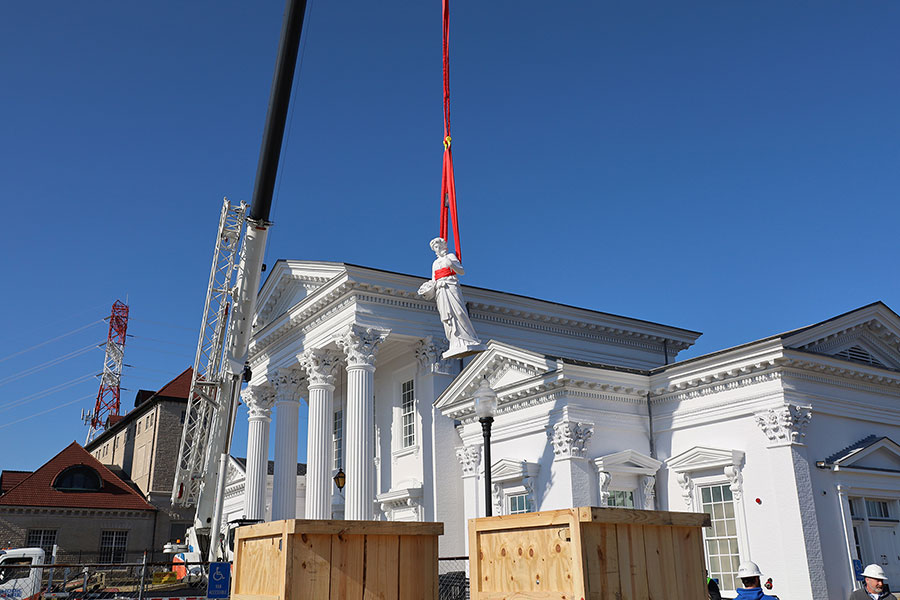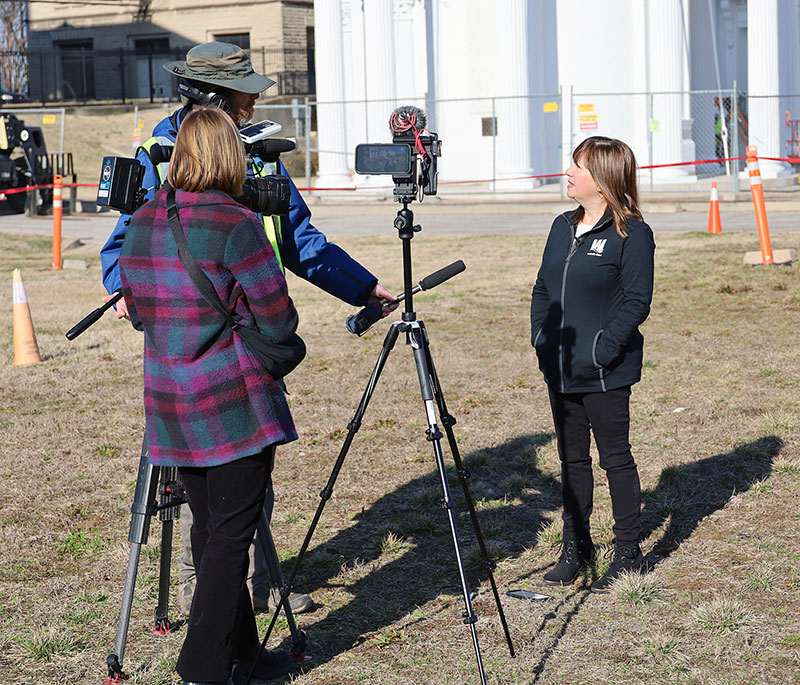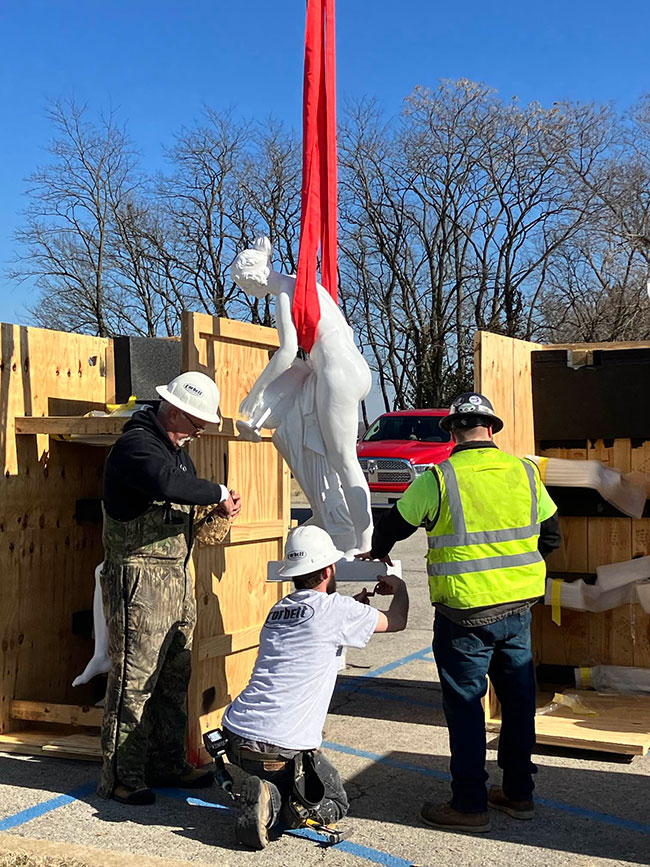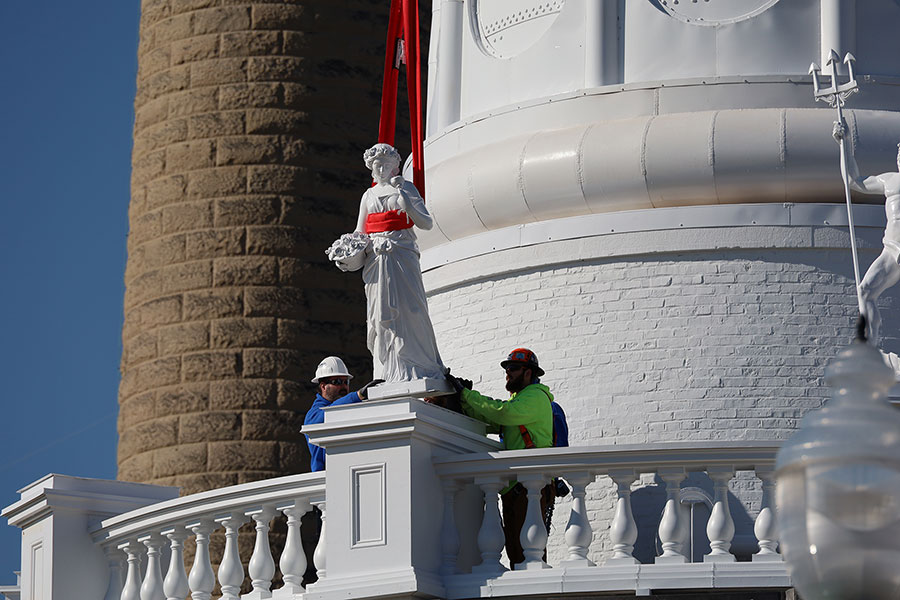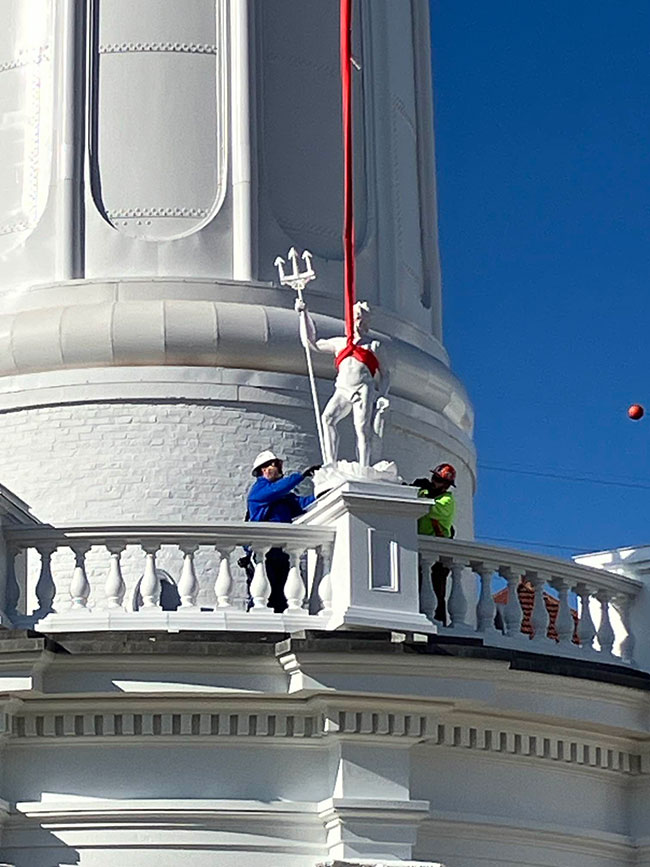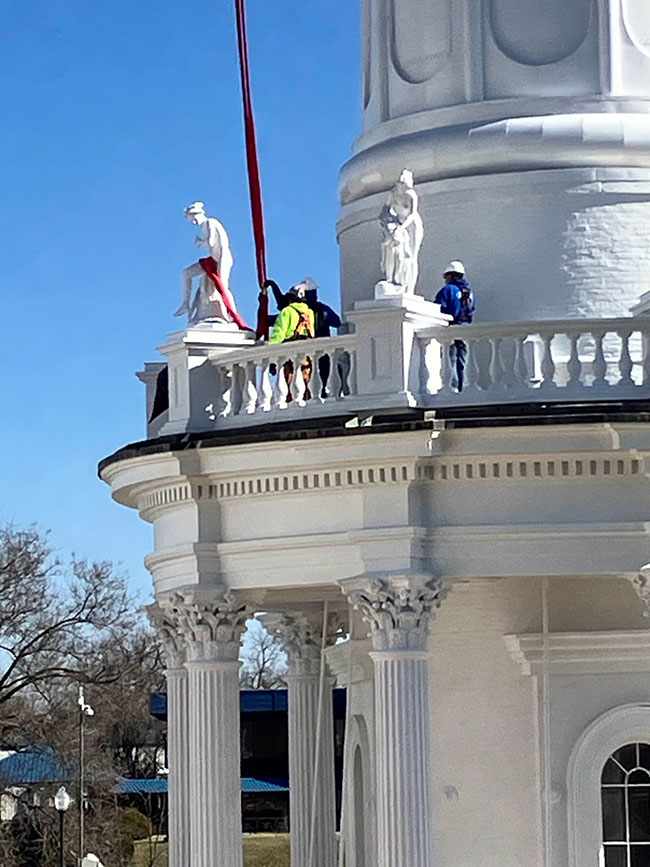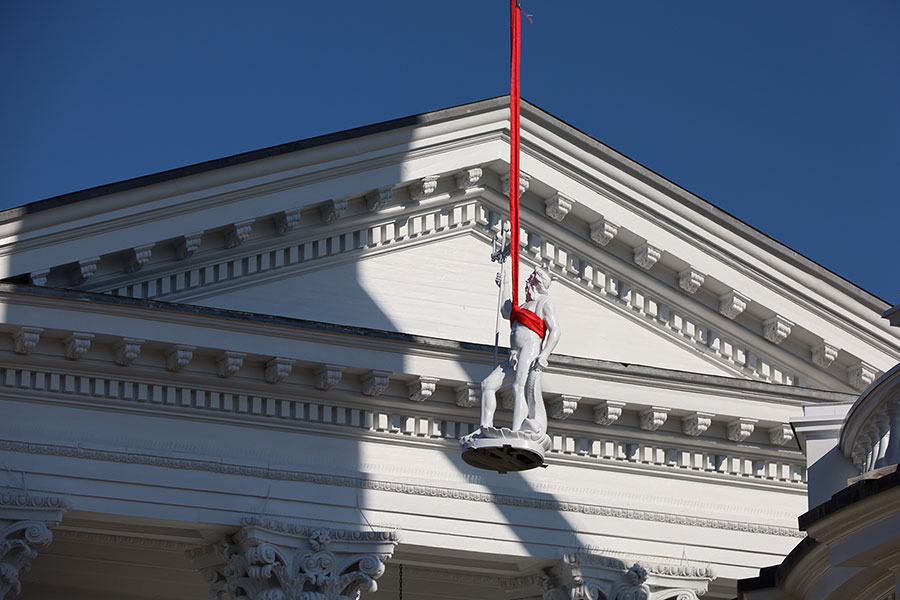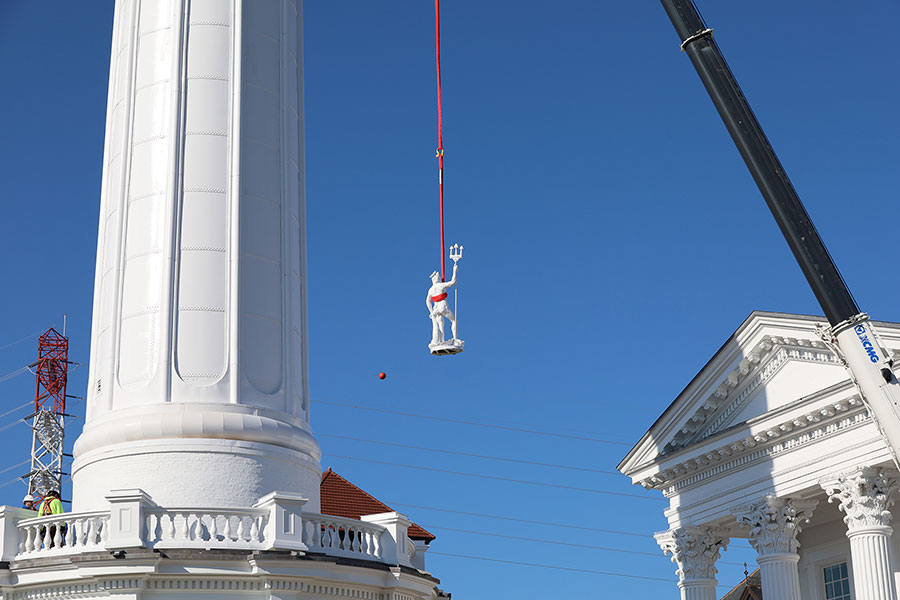Enormous Restoration Project Nears the Finish Line
The Louisville Water Tower is in the final stages of being restored to its magnificent beauty. The scaffolding is gone and on February 13, crews began the meticulous task of hoisting the 10 statues back on the balustrade of the Tower.
“Very excited for them to go back home,” said Megan Jones, Louisville Water supervisor of event operations. “Their facelift is complete. They’re ready to stand tall.”
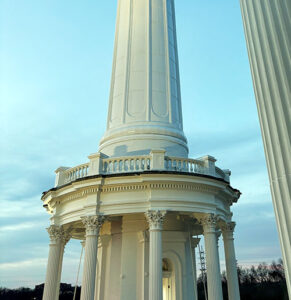 The statues were removed in October 2020 as Louisville Water prepared to restore the Tower and Pumping Station No. 1. Dating back to 1860, the facilities are National Historic Landmarks and the Tower is the oldest ornamental tower in the United States. The statues were sent to an architectural restoration facility in Washington, D.C. for repair and were stored in large protective crates. Since the summer of 2022, scaffolding has covered the Tower and pumping station as crews restored the facilities that were constructed in 1860 as part of the original Water Works.
The statues were removed in October 2020 as Louisville Water prepared to restore the Tower and Pumping Station No. 1. Dating back to 1860, the facilities are National Historic Landmarks and the Tower is the oldest ornamental tower in the United States. The statues were sent to an architectural restoration facility in Washington, D.C. for repair and were stored in large protective crates. Since the summer of 2022, scaffolding has covered the Tower and pumping station as crews restored the facilities that were constructed in 1860 as part of the original Water Works.
Now that the restoration project is nearly complete, the statues will return to their posts on the balustrade of the Tower.
Why all the attention on 10 statues?
 Louisville Water Tower and Pumping Station No. 1 are National Historic Landmarks and in 1860 were the original facilities for Louisville Water, Kentucky’s first public drinking water provider. The founders chose a grand architectural statement for buildings that would hold a standpipe, steam engines, and boilers with hopes that skeptical Louisvillians would abandon their well water and pay for tap water.
Louisville Water Tower and Pumping Station No. 1 are National Historic Landmarks and in 1860 were the original facilities for Louisville Water, Kentucky’s first public drinking water provider. The founders chose a grand architectural statement for buildings that would hold a standpipe, steam engines, and boilers with hopes that skeptical Louisvillians would abandon their well water and pay for tap water.
Louisville Water added the current statues to the Tower in the early 1900s following a tornado in 1890 that snapped the Tower at its base, destroying most of the original statues.
When rebuilding the Tower, Louisville Water purchased 10 zinc statues from J.W. Fiske Foundry in New York. There are nine Greek and Roman gods and goddesses along with an Indian Hunter and his dog. The assortment of statues has long provided fascination. Handwritten notes in Louisville Water’s archives show the company purchased the statues as a group for $1,700.
Though no longer operational for water production, Louisville Water Tower and Pumping Station No. 1 are home to the WaterWorks Museum and the site of weddings, events, and festivals.
Restoring the Louisville Water Tower and Pumping Station No. 1
For the original pumping station, crews removed all exterior paint down to the original wood and brick and repaired and repainted the ornamental work.
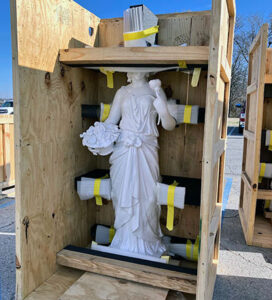 Reinstalling the statues on the Tower is one of the final steps in a restoration project that’s stretched more than three years. The project started in 2020 with a forensic investigation of the materials on the Tower to determine the cause of decay and corrosion. Then in 2022, crews began an $8 million dollar project to repair the Tower and the exterior of the original Pumping Station No. 1.
Reinstalling the statues on the Tower is one of the final steps in a restoration project that’s stretched more than three years. The project started in 2020 with a forensic investigation of the materials on the Tower to determine the cause of decay and corrosion. Then in 2022, crews began an $8 million dollar project to repair the Tower and the exterior of the original Pumping Station No. 1.
Scaffolding soaring nearly 180 feet covered the Tower as crews stripped paint, replaced decayed wood and corroded metal, repaired intricate ornamental details, and repainted it. Similar work happened inside the Tower with special attention on controlling moisture that damaged the interior.
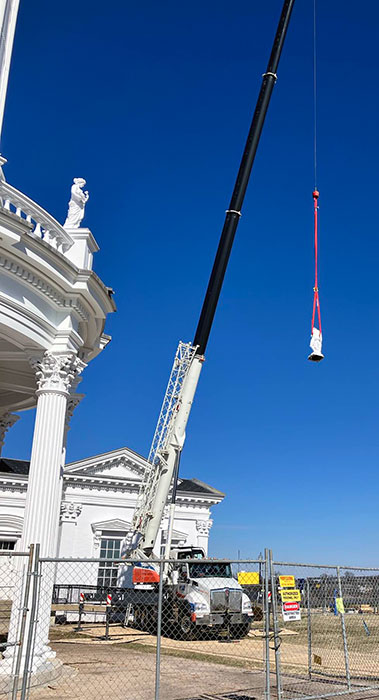 The project has been a big undertaking for Corbett Construction, but one filled with pride.
The project has been a big undertaking for Corbett Construction, but one filled with pride.
“It’s something I really admire about Louisville Water. They take care of their heritage,” President of Corbett Construction, Eddie Corbett shared. “Like all the Louisville Water jobs I’ve done, they’re going to be here long after we’re gone. It’s probably the most eyes I’ve ever had on one of my projects. I’m getting a lot of compliments from people as far as taking care of the heritage, making it sparkle. It’s mementos, taking a lot of pictures to show my grandkids.”
Louisville Water is committed to preserving this iconic structure. It symbolizes the quality and innovation that Louisville Water has embodied for more than 163 years.
After a few additional weeks of cleanup, Louisville Water will reopen the WaterWorks Museum to the public in March 2024.



